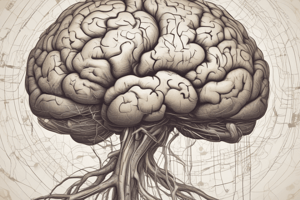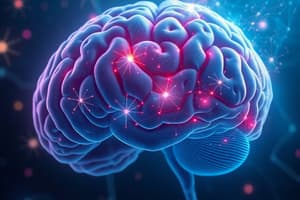Podcast
Questions and Answers
Which of the following structures do fibers enter after passing posterior to the anterior commissure?
Which of the following structures do fibers enter after passing posterior to the anterior commissure?
- Habenular nuclei
- Anterior nuclei of the thalamus
- Lateral preoptic area
- Tegmentum of the midbrain (correct)
What is a significant function of the limbic system related to memory?
What is a significant function of the limbic system related to memory?
- Regulating blood pressure
- Processing visual stimuli
- Converting short-term memory to long-term memory (correct)
- Coordinating muscle movements
Which area does NOT receive fibers that pass anterior to the anterior commissure?
Which area does NOT receive fibers that pass anterior to the anterior commissure?
- Septal nuclei
- Lateral preoptic area
- Anterior part of the hypothalamus
- Tegmentum of the midbrain (correct)
What aspect of behavior is primarily influenced by the function of the limbic system?
What aspect of behavior is primarily influenced by the function of the limbic system?
Which structure serves as the major output pathway of the limbic system?
Which structure serves as the major output pathway of the limbic system?
What is the primary role of the reticular formation in the central nervous system?
What is the primary role of the reticular formation in the central nervous system?
What roles do the reticulospinal and reticulobulbar tracts play in muscle control?
What roles do the reticulospinal and reticulobulbar tracts play in muscle control?
Which column of the reticular formation contains intermediate-sized neurons?
Which column of the reticular formation contains intermediate-sized neurons?
Which tract is associated with the reticular formation's efferent projections to the spinal cord?
Which tract is associated with the reticular formation's efferent projections to the spinal cord?
What is the primary function of reciprocal inhibition in muscle activity?
What is the primary function of reciprocal inhibition in muscle activity?
Which structure provides a primary cortical input to the reticular formation?
Which structure provides a primary cortical input to the reticular formation?
How do the vestibular pathways assist with muscle control?
How do the vestibular pathways assist with muscle control?
What type of outflow does the reticular formation influence within the autonomic nervous system?
What type of outflow does the reticular formation influence within the autonomic nervous system?
What is indicated by the separation of descending tracts from corticobulbar fibers?
What is indicated by the separation of descending tracts from corticobulbar fibers?
What do the polysympathetic pathways refer to?
What do the polysympathetic pathways refer to?
Which nuclei are part of the extensive projections from the reticular formation?
Which nuclei are part of the extensive projections from the reticular formation?
What effect does a stroke involving corticobulbar fibers have on facial muscle control?
What effect does a stroke involving corticobulbar fibers have on facial muscle control?
Which of the following is the smallest neuron type found in the reticular formation?
Which of the following is the smallest neuron type found in the reticular formation?
Where does the reticular formation extend upwards within the CNS?
Where does the reticular formation extend upwards within the CNS?
What anatomical structure assists in controlling respiratory muscles?
What anatomical structure assists in controlling respiratory muscles?
Where do the nerve fiber bundles known as fimbria originate?
Where do the nerve fiber bundles known as fimbria originate?
What primary function does acetylcholine serve in the context of the limbic system?
What primary function does acetylcholine serve in the context of the limbic system?
Which structure is NOT part of the hippocampal formation?
Which structure is NOT part of the hippocampal formation?
What anatomical feature identifies the hippocampus in coronal section?
What anatomical feature identifies the hippocampus in coronal section?
What is the role of the medial and lateral longitudinal striae?
What is the role of the medial and lateral longitudinal striae?
What is the distinguishing characteristic of the cortical structure in the parahippocampal gyrus?
What is the distinguishing characteristic of the cortical structure in the parahippocampal gyrus?
Which statement about the transition in layering from the hippocampus to the dentate gyrus is correct?
Which statement about the transition in layering from the hippocampus to the dentate gyrus is correct?
The indusium griseum is located above which structure?
The indusium griseum is located above which structure?
Which function is primarily associated with the limbic system?
Which function is primarily associated with the limbic system?
What is the primary function of the mammilothalamic tract?
What is the primary function of the mammilothalamic tract?
Which structure serves as the connection point between the two hippocampi?
Which structure serves as the connection point between the two hippocampi?
Which of the following structures emerges from the posterior aspect of the amygdaloid nucleus?
Which of the following structures emerges from the posterior aspect of the amygdaloid nucleus?
From where do the fibers that connect to the hippocampus via the longitudinal striae arise?
From where do the fibers that connect to the hippocampus via the longitudinal striae arise?
What is the route taken by fibers arising from the dentate and parahippocampal gyri?
What is the route taken by fibers arising from the dentate and parahippocampal gyri?
Which pathway is NOT directly involved in connecting the hippocampus with other structures?
Which pathway is NOT directly involved in connecting the hippocampus with other structures?
Which of the following is a function of the commissure of the fornix?
Which of the following is a function of the commissure of the fornix?
Which part of the brain is primarily associated with olfactory processing before connecting to the hippocampus?
Which part of the brain is primarily associated with olfactory processing before connecting to the hippocampus?
Flashcards are hidden until you start studying
Study Notes
Reticular Formation Overview
- Composed of nerve cells and fibers resembling a net, extending from the spinal cord to the cerebellum.
- Contains three longitudinal columns: median (intermediate neurons), medial (large neurons), and lateral (small neurons).
- Involved in sensory processing and modulation throughout the central nervous system.
Efferent Projections
- Extends to the brainstem and spinal cord, encompassing reticulobulbar and reticulospinal tracts.
- Plays a key role in autonomic nervous system outflow, affecting sympathetic and craniosacral parasympathetic responses.
- Pathways connect to structures including the corpus striatum, cerebellum, and various thalamic nuclei.
Functions of the Reticular Formation
- Controls skeletal muscle activity by influencing alpha and gamma motor neurons.
- Modulates muscle tone and reflex activity, facilitating reciprocal inhibition between flexor and extensor muscles.
- Assists vestibular apparatus in maintaining antigravity muscle tone.
- Involved in respiratory control via brainstem centers, influencing respiratory muscles.
Limbic System Overview
- A group of structures located at the border between the cerebral cortex and hypothalamus, crucial for emotion, behavior, and drives.
- Includes the hippocampal formation and amygdaloid nucleus, playing significant roles in memory and emotional responses.
Hippocampal Formation
- Composed of the hippocampus, dentate gyrus, and parahippocampal gyrus, functioning in memory and spatial navigation.
- The hippocampus has a unique curved structure resembling a sea horse, located in the lateral ventricle's inferior horn.
- The parahippocampal gyrus is a six-layered cortical structure transitioning to a three-layered arrangement in the hippocampus.
Amygdaloid Nucleus
- Plays a crucial role in emotion regulation, particularly fear and aggression.
- Connected to the hippocampus via the fornix and other pathways, facilitating emotional memory processing.
Connecting Pathways of the Limbic System
- Features multiple fiber tracts connecting various regions, including the mammillary body and thalamus, enhancing communication within the limbic system.
- Efferent connections target hypothalamic areas, influencing autonomic and endocrine functions related to emotional states.
Functions of the Limbic System
- Regulates autonomic nervous system outflow and its effects on the endocrine system.
- Essential for emotional behaviors, including fear, anger, and sexuality.
- Involved in memory consolidation, transforming short-term memories into long-term storage.
Studying That Suits You
Use AI to generate personalized quizzes and flashcards to suit your learning preferences.




